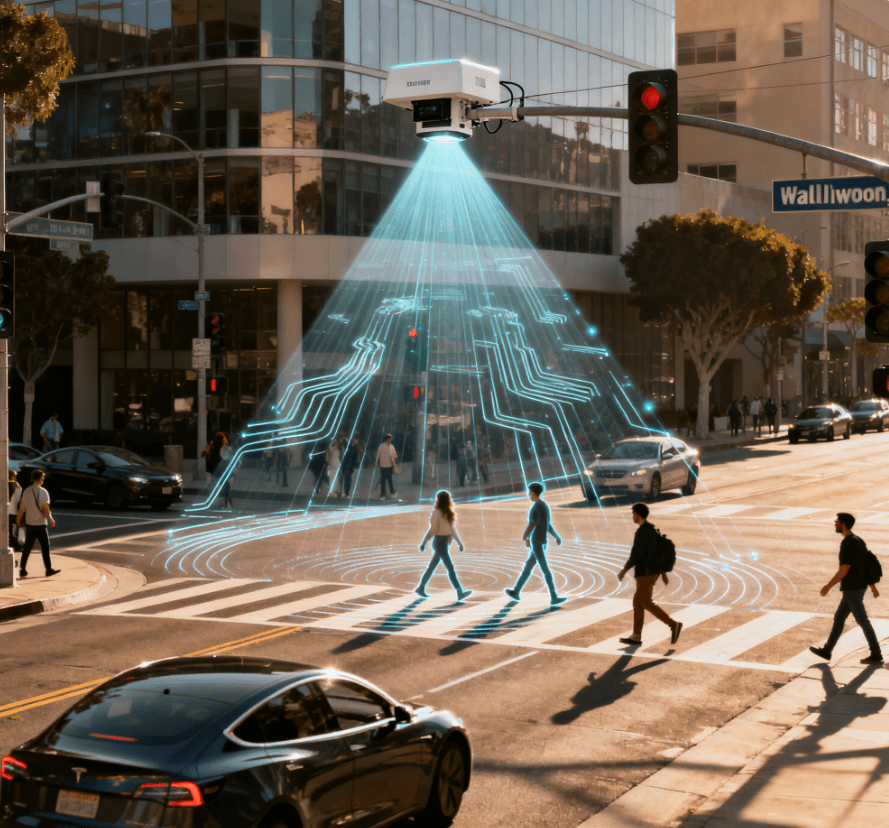West Hollywood’s Melrose Avenue infrastructure upgrade represents a paradigm shift in urban mobility. Far beyond a traditional road resurfacing, this “smart city ready” initiative leverages cutting-edge sensing technology to optimize traffic flow, enhance pedestrian safety, and provide city managers with actionable insights.
Urban planners, technology experts, and smart city enthusiasts alike are keen to understand the technology powering this transformation. Central to the project is 4D mmWave radar, which addresses the limitations of conventional traffic sensing while offering long-term operational reliability and scalability.
1. The Challenges of Traditional Urban Sensing
Implementing a robust smart street system requires continuous tracking of vehicle movement, pedestrian activity, and parking space utilization. Traditional sensing technologies introduce three key challenges:
1.1 Inconsistent Data Quality
Conventional optical cameras are highly sensitive to weather conditions, lighting variations, and glare, which can lead to incomplete or unreliable data. For instance, during heavy rain or nighttime hours, many camera-based systems struggle to detect vehicles or pedestrians accurately.
-
Impact: Unreliable data can compromise adaptive traffic signal timing, resulting in longer wait times, increased congestion, and reduced commuter satisfaction.
1.2 Limited Sensing Dimensions
Inductive loops and conventional 3D radar systems capture basic distance and velocity but lack elevation data and advanced trajectory tracking. Without this, differentiating between cars, motorcycles, bicycles, and pedestrians in complex urban environments becomes challenging.
-
Impact: Cities relying on limited-scope sensors face early obsolescence, often requiring expensive secondary technology upgrades to support autonomous vehicle (AV) integration or fine-grained traffic analytics (IEEE Smart Cities, 2024).
1.3 Privacy and Regulatory Compliance
Large-scale deployment of optical sensors can inadvertently capture personally identifiable information (PII), triggering legal and ethical concerns. Cities must invest significantly in data protection, compliance measures, and public communication, which can delay smart city initiatives.
-
Impact: Slows technology adoption and increases operational costs.
Conclusion: A resilient, future-ready traffic system requires a sensor technology capable of delivering high-precision, all-weather data while ensuring privacy.
2. 4D mmWave Radar: A Technological Breakthrough
Linpowave’s 4D mmWave radar is designed to overcome these challenges, offering robust, high-resolution perception for urban environments.
2.1 Continuous, All-Weather Data Reliability
Operating at 77–81 GHz, 4D mmWave radar waves penetrate rain, fog, snow, and darkness, capturing reliable movement data regardless of conditions (MDPI Sensors, 2025).
-
Impact: Cities gain 24/7 continuous monitoring, enabling adaptive traffic control and dynamic resource allocation. This stability ensures smart city investments yield predictable long-term ROI, as decisions are always supported by accurate, real-time data.
2.2 High-Dimensional Sensing
While 3D radar captures distance, velocity, and azimuth, 4D radar adds elevation data, creating a more complete spatial representation of traffic scenes.
-
Benefits:
-
Differentiates cars, trucks, bicycles, pedestrians, and even low-flying drones.
-
Supports Level 4 autonomous vehicles and V2X communication, providing high-quality roadside perception for next-generation traffic management.
-
Enables advanced trajectory tracking, allowing proactive interventions such as predictive pedestrian alerts.
-
2.3 Privacy-First Design
4D mmWave radar does not capture images or personally identifiable information, only geometric and motion data.
-
Impact: Cities can deploy sensors at scale without violating privacy laws, reducing compliance costs and public resistance.
3. West Hollywood in Action: Translating Data into Urban Benefits
Linpowave 4D radar sensors are integrated into smart street lighting poles, providing actionable insights for traffic management, pedestrian safety, and parking optimization.
3.1 Adaptive Traffic Control
-
Implementation: Radar continuously monitors vehicle density, queue lengths, and speeds. Traffic lights dynamically adjust in response to real-time conditions.
-
Quantified Outcomes: Early pilot data shows average vehicle idle time reduced by 18%, translating to lower fuel consumption and carbon emissions, directly contributing to the city’s ESG goals.
3.2 Predictive Pedestrian Safety
-
Implementation: Radar tracks pedestrians and cyclists in real time, providing preemptive alerts in potential conflict zones.
-
Quantified Outcomes: The system reduced near-miss incidents by approximately 22%, shifting the city’s safety approach from reactive to proactive prevention, while minimizing potential liability costs.
3.3 Smart Curbside and Parking Management
-
Implementation: Continuous radar monitoring tracks parking occupancy and curbside utilization.
-
Quantified Outcomes: Reduced cruising for parking by 15–20%, lowering unnecessary traffic circulation and enabling time-based curbside management, such as EV charging or loading zones.
Authority Reference: California Department of Transportation – Smart Traffic Initiatives
4. Integration and Scalability
Cities often expand municipal fiber networks to support smart city infrastructure. Linpowave 4D radar modules provide standardized communication interfaces, allowing seamless, high-bandwidth data transfer to city data platforms.
-
Benefit: Enables real-time integration with other urban systems, including emergency services, urban planning tools, and autonomous vehicle networks.
5. Strategic Considerations (FAQ)
Q1: What is the long-term value of 4D mmWave radar for cities?
A1: Provides technological certainty by supporting autonomous vehicle and V2X standards, reducing the risk of expensive secondary upgrades over 5–10 years.
Q2: Does 4D radar face integration challenges?
A2: No. Standardized interfaces and municipal network expansions ensure smooth integration with city platforms.
Q3: Why is 4D radar more privacy-compliant than cameras?
A3: Non-optical design ensures no images or personal identifiers are captured, maintaining privacy compliance without compromising sensing accuracy.
6. Conclusion: Defining the Future of Smart City Traffic
West Hollywood illustrates that 4D mmWave radar is not merely a sensor, but a core enabler of sustainable, efficient, and privacy-conscious urban mobility.
-
Impact: Optimizes traffic flow, protects pedestrians, reduces emissions, and provides data-driven urban management.
-
Future Vision: Cities aiming for zero-accident goals and future-ready traffic systems can adopt 4D mmWave radar as the standard for intelligent mobility and urban sensing.



